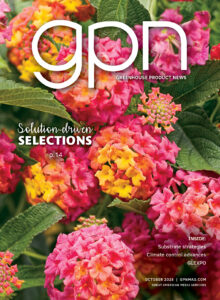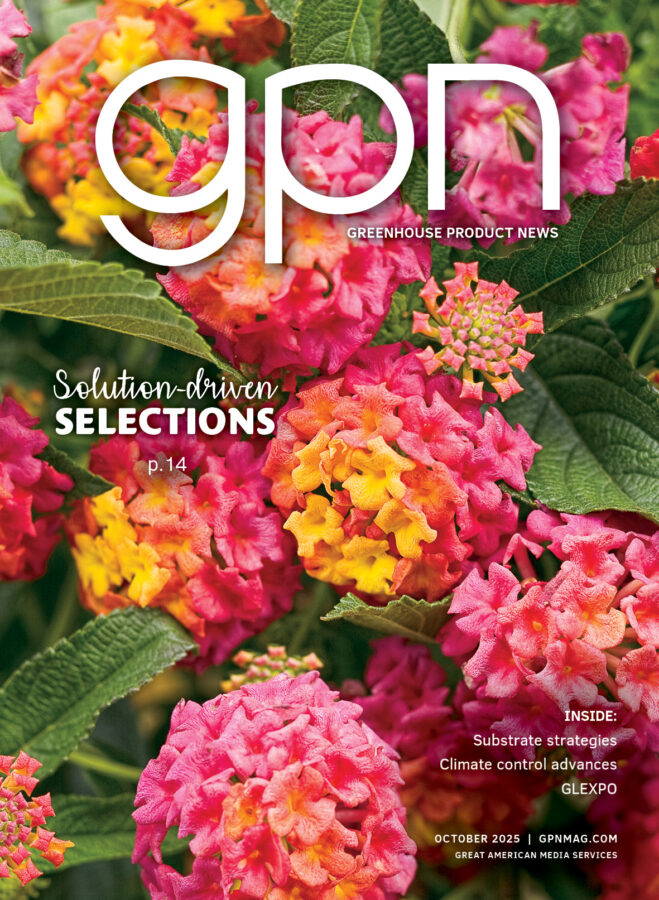Duets: Consumer behavior and the economics of profitability
Today’s guest is Alicia Rihn, assistant professor at the University of Tennessee. Alicia earned an undergraduate degree from the University of Wisconsin and master’s and doctorate degrees from the University of Minnesota. Her research program is focused on specialty crop marketing with an emphasis on ornamental plants. She was recently recognized as a member of GPN’s 40 Under 40 Class of 2022.
Peter: Thanks for writing with me Alicia, and congratulations on being a GPN 40 Under 40 recipient. Let’s start with how you became interested in agricultural economics.
 Alicia: I grew up in a small town, participating in 4-H and Future Farmers of America. Corn, soybeans and hogs were the primary ag products grown in the area. When I went to college, I wanted to remain in the industry but not monoculture ag. I discovered horticulture in my intro to plant sciences course and decided to pursue a degree in horticultural sciences. When I was getting close to graduation, I realized there were not a lot of agriculture business courses taught, and I wanted to fill that gap. So I pursued graduate work in agricultural economics with a focus on consumer behavior toward specialty crops.
Alicia: I grew up in a small town, participating in 4-H and Future Farmers of America. Corn, soybeans and hogs were the primary ag products grown in the area. When I went to college, I wanted to remain in the industry but not monoculture ag. I discovered horticulture in my intro to plant sciences course and decided to pursue a degree in horticultural sciences. When I was getting close to graduation, I realized there were not a lot of agriculture business courses taught, and I wanted to fill that gap. So I pursued graduate work in agricultural economics with a focus on consumer behavior toward specialty crops.
At that time, it was near the Great Recession and the local movement had taken off, so a lot of my work focused on local plants and fresh produce. People and their responses are very dynamic, so it was interesting to see how people respond to different stimuli or marketing materials, and to identify what can encourage a more positive shopping experience, while driving up sales.
Peter: It interests me that given our different areas of expertise, mine in production and yours in economics, and the generational staggered overlap of our careers, we both share a focus on the locally grown food movement. My podcast partner Michelle Klieger, also an agricultural economist and past contributor in this column, and I enjoyed having you as a guest on our podcast “The Grower and the Economist” in the spring of 2021. We discussed grower response and reaction to the pandemic, as well as some of your research from your graduate studies and current work at Tennessee. One of your research projects is exploring how to engage new consumers. What are you learning?
Alicia: As new gardeners are entering the marketplace, they are inexperienced and information-seeking. This poses an interesting opportunity for the industry to inform and generate value for this group. We found that people who are engaging with plants are younger, more educated, have children and have a higher income than those who are not engaging with plants.
A larger portion of millennials and Gen Z consumers are engaging with plants as well. Of our national sample, 45% had less than two years of experience. When we looked at the benefits associated with plants, the perceived benefits (e.g., plants make me happy) increased as years of experience increased. This implies that as people gain experience, they also gain in the positive benefits of working with plants.
Peter: A momentary detour please as we get into more research results … Understanding new consumers is critical to our industry’s growth; I get that. Put these new consumers into the bigger picture of our complete customer base. What are the different consumer segments, and how big are the different pie slices? Yes, we need to learn how to reach new consumers and communicate with them. But, simultaneously, we have older, loyal gardeners deserving continued attention as well.
Alicia: Good question, Peter. There are several different customer segments interested in gardening. In general, there is a more mature, experienced gardening group who is historically the core consumer of ornamental plants and then the new consumer who tends to be younger and less experienced. Depending on who you are targeting, these two groups come together on wanting a high-quality product that matches their wants and needs.
However, they also have some differences. For instance, the term “gardener” does not necessarily resonate well with new consumers; rather, they prefer plant lover, parent or saver to identify their interest. Gaining more knowledge about plants was the primary activity that participants identified as a means of improving their engagement with plants.
They also use online tools to gain knowledge related to plants and gardening. Google search was their primary source for plant information, followed by asking a close friend or relative, online videos, books, and social media. In general, first-time plant buyers were more receptive to online plant purchases and following growers or retailers on social media than existing customers.
Peter: We growers are benefiting from next-gen researchers like you. With the help of my son, daughter and grandkids, I’m being guided — no, lectured — on how to observe and react appropriately so as not to elicit that snarky comment: “OK, boomer.” Thanks again for putting some science to social behavior. Switching gears, native plants continue to ascend on the production side of horticulture. You are conducting research specific to native plants, correct?
Alicia: In our recent Horticulture Research Institute (HRI) study of 2,066 U.S. consumers, we found that about 58% of the sample purchased native plants in 2021 and spent (on average) $178.26 annually on those plants. The majority of participants (83%) indicated that incorporating native plants into their own gardens and landscapes was moderately to extremely important.
The key benefits driving native plant sales were identified as pollinator friendly, complementing previous installments, natural habitat restoration, aesthetics and wildlife attractiveness. Highlighting these benefits in point-of-sale promotions could be a means to encourage purchasing of native plants.
Peter: Yeah, I have to stop you right there. To me, “wildlife attractive” is code for deer damage. I’m reeling from decades of deer destruction to my landscape. I know that’s not the only wildlife you’re referencing, but the gardener in me is permanently traumatized by them.
Alicia: I, too, have deer-related issues involving neighbors feeding them. In this study, wildlife was left more broadly defined and encompassed birds and wildlife people enjoy watching in their landscapes, which includes deer in some instances, depending on the person.
Peter: My gosh, we must have the same neighbor, Alicia. Mine fed the deer for several winters a while ago and stopped after they overstayed their welcome and grazed his summer garden. You mentioned birds; don’t get me started on the wild turkeys.
Alicia: Interestingly, we did ask if participants perceived native plants as encouraging or deterring wildlife, and they viewed native plants as more encouraging to wildlife than introduced plants. Consumers would likely benefit from knowing the types of wildlife that are attracted to those species, so they can attract their preferred wildlife instead of inadvertently starting a neighborhood deer farm.
Additionally, there was a positive relationship between environmentally friendly gardening practices (e.g., recycling containers, composting, pollinator-friendly plants, lower-input plants, rain barrel use) and purchasing native plants. The implication is that offering products and information that support these gardening actions may be one means of encouraging native plant purchases.
Peter: Global issues including climate change and agricultural sustainability are front page stories. Do trends you report on native plants correlate with these larger issues? Do you find that different generations of consumers view these issues similarly or differently?
Alicia: Peter, consumers are very interested in sustainability measures. This trend is particularly relevant for younger generations (millennials and Gen Z). Of particular interest are production practices that result in great quality products but are grown in a way that benefits the environment, community, society, etc. This really ties into their concerns about climate change and the desire to aid the environment. They are also interested in getting high-quality products through convenient channels, such as e-commerce sales.
Peter: You mentioned work in the area of controlled environment agriculture (CEA). Much of my research is in this arena and I’d like to understand how consumers are reacting to this sector compared to traditional, industrial-scale
agriculture.
Alicia: CEA is very interesting because people view this as an opportunity to grow fresh fruits and vegetables close to the retail outlet. So potential benefits include a higher-quality product due to less transportation, more jobs in the local community and a means of mitigating environmental issues related to production, due to control over all inputs.
These are perceived benefits because there is still a lot of work to be done in this area to identify the demand for CEA products and how much product needs to be
sold in order to cover additional overhead costs. I’m currently working on a project focusing on consumers’ responses to leafy greens, microgreens and herbs grown in CEA to enhance phytonutrient content.
Essentially, can we manipulate the growing environment to increase phytonutrients — and then are consumers interested in these products? Will they pay more for them? Does it matter to the customer? Ultimately, we want a holistic picture of the business and consumer side of CEA production of these items.
Peter: Bingo! And that’s how our complementary research worlds merge. We need to collaborate, growers and sellers, to figure out how CEA fits into the global food production puzzle. Any final thoughts?
Alicia: Thank you for having me, Peter. I appreciate the opportunity to share my work with you and the industry folks reading. Moving forward, I am hoping to gain more insights from the industry to incorporate into my projects and would greatly appreciate any feedback related to marketing and consumer behavior that you all would be willing to share.
Peter: You’re very welcome; thanks for joining me and keep up the great work.
For an enhanced reading experience, view this article in our digital edition by clicking here.









 Video Library
Video Library 


















